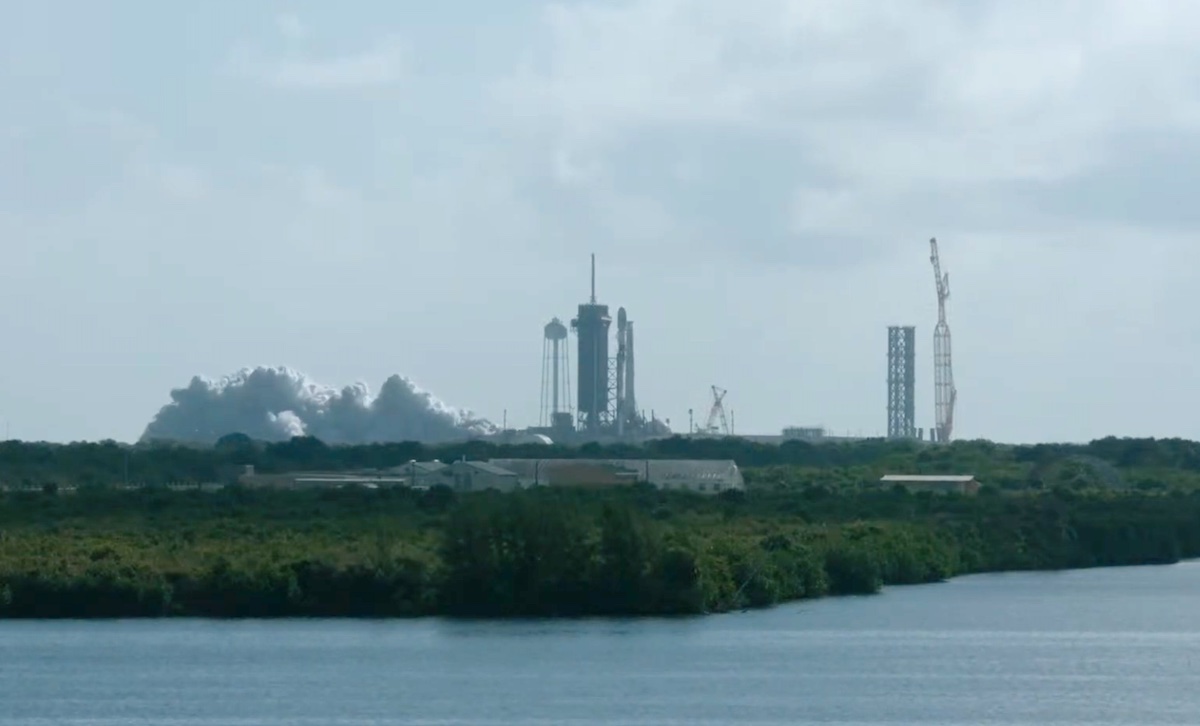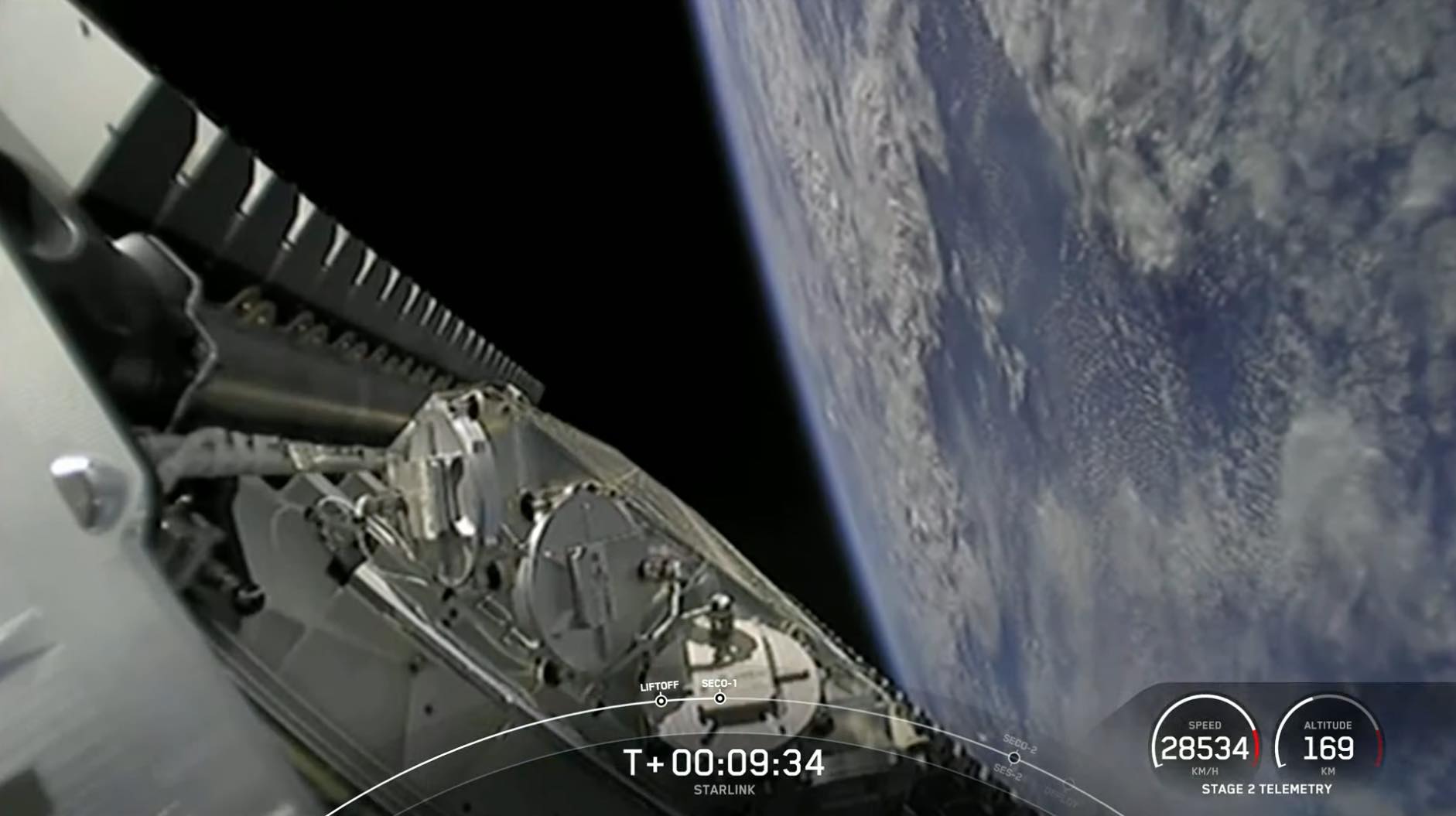
SpaceX test-fired a Falcon 9 rocket at NASA’s Kennedy Space Center Saturday in preparation for liftoff Sunday with the company’s next batch of 53 Starlink internet satellites.
Test-firings on the launch pad were once a customary part of every SpaceX launch campaign, but the company is phasing out the static fire tests for most missions as the Falcon 9 launch cadence has ramped up to an average of one flight per week.
Just a few hours after launching a Falcon 9 rocket with 46 Starlink broadband satellites from Vandenberg Space Force Base in California, SpaceX rolled another Falcon 9 to pad 39A at the Kennedy Space Center Friday to prep for launch Sunday with another 53 internet relay nodes.
But first, SpaceX’s launch team readied the rocket for a static fire test Saturday morning.
Kerosene and liquid oxygen flowed into the Falcon 9 beginning about 35 minutes prior to ignition time. SpaceX engineers in Firing Room 4 of the Launch Control Center at Kennedy observed and managed the operation.
The Merlin engines fired for approximately 7 seconds at 9 a.m. EDT (1300 GMT) Saturday while hydraulic hold-down clamps kept the Falcon 9 firmly on the ground. The engines throttled up to generate 1.7 million pounds of thrust, briefly sending a plume of exhaust out of the flame trench.
SpaceX drained propellants from the rocket after the test-firing, and the company confirmed the mission was on track for liftoff Sunday at 9:38 a.m. EDT (1338 GMT). The mission will mark SpaceX’s 33rd launch of the year, and the 53rd dedicated launch for the Starlink network.
Friday’s launch from California was the 32nd Falcon 9 launch of 2022, breaking the company’s record of 31 launches in a year set in 2021.
Including the static firing Saturday, SpaceX has performed a test-firing on the launch pad prior to six of 33 Falcon 9 missions so far this year. SpaceX conducted the pre-launch test-firing before every Falcon 9 launch until 2020, then gradually decreased the use of static firings.
SpaceX used to require a static firing every time an engine was removed between flights of one of its reusable Falcon 9 boosters. That requirement has changed to perform a pre-launch test-firing only when three or more engines are removed between missions, according to a report published last month by Aviation Week & Space Technology.
The static firings were originally part of each SpaceX launch campaign to ensure engineers caught any problems with the rocket before launch day. But SpaceX has improved its performance launching on time as the test-firings have become less common.
A last-minute abort before a planned launch in California earlier this week was the first time a Falcon 9 launch was scrubbed in the terminal countdown by a technical issue since December 2020. SpaceX logged 62 straight launches from December 2020 until this month without a countdown abort caused by a rocket problem.
And SpaceX has accomplished 141 consecutive successful missions since an explosion during a static fire test in 2016 destroyed a Falcon 9 rocket and the Israeli-owned Amos 6 communications satellite.
SpaceX continues test-firing brand new Falcon 9 rockets on a test stand at the company’s facility in Central Texas, after the boosters leave their factory in Hawthorne, California.

The launch of the Starlink 4-25 mission Sunday will deliver SpaceX’s next 53 Starlink internet satellites into low Earth orbit. The Falcon 9 will climb away from pad 39A and head northeast over the Atlantic Ocean, flying on a course parallel to the U.S. East Coast.
The rocket’s first stage booster will shut down about two-and-a-half minutes into the mission. After separating from the upper stage at the edge of space, the Falcon 9’s first stage will arc toward SpaceX’s drone ship “A Shortfall of Gravitas” parked about 400 miles (650 kilometers) downrange in the Atlantic Ocean, using cold gas thrusters and titanium grid fins to help control its flight path.
Engine burns will slow the rocket down for landing on the drone ship. The booster flying on the Starlink 4-25 mission, known as B1062, will launch on its eighth trip to space. It debuted with the launch of a U.S. military GPS navigation satellite in November 2020, and launched the all-private Inspiration4 and Axiom-1 crew missions in September 2021 and in April of this year.
Most recently, the booster flew June 8 with the Egyptian Nilesat 301 geostationary communications satellite.
While the first stage descends toward landing Sunday, the Falcon 9’s upper stage will burn for about six minutes to place 53 flat-packed Starlink satellites into a transfer orbit ranging in altitude between 144 miles and 210 miles (232 kilometers by 338 kilometers), at an inclination of 53.2 degrees to the equator.
The Falcon 9’s reusable payload fairing will jettison during the second stage burn. A recovery ship is also on station in the Atlantic to retrieve the two halves of the nose cone after they splash down under parachutes.
The satellites — each more than a quarter ton in mass — will separate from the rocket’s upper stage at T+plus 15 minutes, 24 seconds. Four retention rods will jettison to allow the satellites to fly free of the Falcon 9 in orbit. The rods hold the spacecraft onto the rocket during the climb to space.
The Starlink satellites will unfurl their solar panels and use ion propulsion to reach their operational altitude of 335 miles (540 kilometers). The orbit-raising maneuvers typically take a few weeks to a few months, depending on the orbital plane targeted for each spacecraft.
SpaceX has launched 2,904 Starlink satellites going into Sunday’s mission, including prototypes and earlier spacecraft designs no longer in service. The company says its Starlink broadband service is currently available in 36 countries around the world.
Email the author.
Follow Stephen Clark on Twitter: @StephenClark1.
